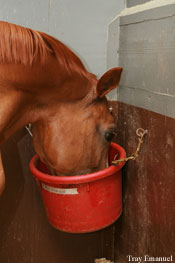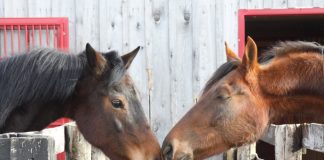 |
The world of nutraceuticals is a confusing one for the consumer. The products look promising, but sometimes the labels read like a foreign language! Here’s a guide to deciphering some of the key ingredients you’re likely to find in oral supplements for horses.
ANTI-OXIDANT: an organic molecule that has the ability to counteract the damaging effects of oxygen in tissues. Although the term technically applies to molecules that inhibit the reaction with oxygen, it’s often applied to molecules that protect from any free radical (molecule with unpaired electron). Beta-carotene, lycopene and vitamin E are three common anti-oxidants found in foods.
BIOTIN: one of the B-vitamins that horses naturally manufacture in their digestive tracts. It can also be sourced from the diet. Biotin’s primary role is as a co-enzyme in several chemical reactions related to metabolism and cell production. It can also improve the growth and quality of hoof horn and hair in some horses, when fed at levels well above what is needed for metabolism.
CHONDROITIN SULFATE: a type of glycosaminoglycan (see below) required for the formation of essential molecules called proteoglycans, in joint cartilage. Chondroitin sulfate is extracted from animal cartilage or connective tissue. Most often, it’s derived from bovine tracheal tissue. Some supplements offer whole, unpurified tissue containing chondroitin sulfate in freeze-dried form. Shark cartilage, extract of perna mussel (a type of sea mollusc) and/or sea cucumber are some examples of these.
Supplementing chondroitin sulfate may decrease the activity of destructive enzymes by binding with them and inactivating them, thus slowing the breakdown of a diseased joint. It may also play a role in stimulating the body to produce more sodium hyaluronate (see below), and provide additional substrates, such as sulfur, for the formation of a healthy joint matrix. However, chondroitin sulfate is a very large molecule, so are questions about whether it passes through the intestinal cell walls to reach a horse’s joints.
CHROMIUM: a trace mineral that is suspected of playing a role in regulating the blood glucose/insulin balance and boosting the immune system. Preliminary studies of chromium-supplemented exercising horses showed they metabolized glucose at a faster rate and had lower levels of cortisol (a hormone produced when horses are stressed), but they also had higher-than-usual heart rates and blood lactate levels. Chromium supplementation enjoys some popularity as a treatment for horses who ‘tie up,’ and as a calming agent, but more research is needed before either use can be substantiated.
ELECTROLYTES: minerals–primarily sodium, potassium, magnesium, and chloride–that exercising horses lose in their sweat and urine. Supplements containing these minerals in the proper proportions can help horses replace them when lost, so they can continue to function normally.
ESSENTIAL FATTY ACIDS (EFAs): Unsaturated fatty acids that are essential to health, but cannot be manufactured in the body. Three types of essential fatty acids are: arachnoidic acid, linoleic acid and alpha-linolenic acid. Omega-3 fatty acids, which are reputed to decrease inflammation in the body, are derived from alpha-linolenic acid, while their chemical ‘cousins,’ the omega-6 fatty acids, are derived from linoleic acid and appear to increase the inflammatory response, constrict the bronchi in the lungs and aggravate allergic responses. EFAs can be derived from grains with a high oil content (such as canola, sunflower, soybean and flax) as well as from fish oils.
GLUCOSAMINE: a constituent of healthy joint fluid and an essential ingredient in most of the body’s connective tissues, including tendons, ligaments, skin, hooves, heart valves, blood vessels and cell membranes. Glucosamine is vital for the horse to heal damaged cartilage. In theory, providing glucosamine to joint cells stimulates them to produce more glycosaminoglycans (GAGs), including sodium hyaluronate. However, there’s considerable debate as to whether glucosamine, given orally, actually reaches arthritic joints intact to produce GAGs. Supplements may use either glucosamine sulfate or glucosamine hydrochloride (opinions differ as to which is better).
HYALURONIC ACID (HA): a type of sugar chain, also known as sodium hyaluronate, that arranges itself in complicated coils, adapting to the pressure changes in the joint capsule as the horse moves. It assures the unhindered passage of metabolites to and from the joint, and also serves as a stabilizer and shock absorber for the structures that undergo continuous, changing mechanical stresses. It is given as an injectable, but is more recently available as an oral supplement as well.
MACRO-MINERALS: minerals that the horse needs in comparatively large quantities to maintain a healthy metabolism. Calcium, phosphorus, sodium, chloride, magnesium, sulfur and potassium are generally considered the important macro-minerals. See also TRACE MINERALS.
MAGNESIUM: a macro-mineral which has a reputation for inducing a calming effect on horses, as well as decreasing the risk of laminitis and obesity in insulin-resistant animals–effects which have not yet been confirmed by research. Fortunately, horses have a relatively high tolerance for magnesium, but over-supplementing can lead to heart conduction problems and kidney dysfunction. Epsom salts, one common magnesium source, also have a laxative effect on horses so should be fed in limited quantities.
METHIONINE: an amino acid (building block of protein) that contains sulfur. Considered important in the formation of strong, healthy hoof horn and haircoat. Often included in hoof supplements containing biotin.
PRE-BIOTIC: a feed supplement intended to encourage the healthy growth and maintenance of beneficial bacteria that live in the horse’s digestive tract and are essential for fiber digestion.
PRO-BIOTIC: a feed supplement containing live bacterial cultures, intended to supplement the populations of beneficial bacteria already living in the gut. Often given after an illness or a course of antibiotics has wiped out populations of the beneficial “bugs.”
PSYLLIUM: the seed husks of the psyllium plant (Plantago ovata), sometimes called desert Indianwheat, are high in fiber and mucilage (a sticky carbohydrate). When combined with water, they swell many times their original size and become slimy and gelatinous. Feeding psyllium husks to horses that graze in arid, sandy conditions can help pick up sand deposits in the gut and move it through to be expelled in the manure, thus reducing the risk of sand colic. Horses being fed psyllium should have constant access to plenty of fresh water.
SELENIUM (Se): a trace mineral that functions in partnership with vitamin E to help protect tissues from free-radical damage. Selenium also plays a role in the control of thyroid hormone metabolism. Supplementing selenium can be risky because it is one of the few minerals that has a very narrow range of safety. Because the toxicity level of it is so low, you must be aware of the Selenium content of your soil (which affects your pasture and hay) before you supplement. Most areas of North America are Selenium-deficient, but a few areas contain high levels in the soil (such as some pockets of the Rocky Mountains), making supplementation unwise.
TRACE MINERALS: minerals the horse needs in only minute quantities to maintain good health. They include iodine, selenium, cobalt, manganese, iron, zinc, copper and chromium.
VALERIAN: since before the Middle Ages, people have used the herb Valeriana officinalis to decrease nervous tension and anxiety, relax muscle spasms, and encourage restful sleep. Although it is not addictive, it does have powerful tranquilizing qualities considered performance-altering, so this herb is considered a banned substance in most kinds of recognized competition.
VITAMIN C: Also known as ascorbic acid. Unlike humans, horses manufacture vitamin C naturally in their tissues, so they have no dietary need for it.
VITAMIN E: Versatile vitamin E works in concert with selenium to enhance immune function, aid cellular respiration and DNA synthesis, and improve the absorption and storage of other vitamins. But most importantly, it is an anti-oxidant which helps protect the horse’s tissues from oxidative damage. Dietary sources include growing forage, although 30-80 percent of the vitamin’s activity is lost during the cutting and baling of hay.
Find out how to analyze feed labels.






Good article. The more info the better.
Vitamin E also has an effect on a horses need to eat. A horse deficient in vitamin E will either not eat or be unable to eat normal quantities (such as a person recovering from anorexia) of hay or grain. When the horse becomes severely deficient it may take months, years or the horse may never recover to eating normal rations. This happens a lot with starved horses. I have witnessed and taken care of a horse first hand that I now own that was starved and couldn’t eat even a quarter of a flake of hay and now is back to normal. It took a long time
I found this article to most useful. I certainly had some confusion on supplements.